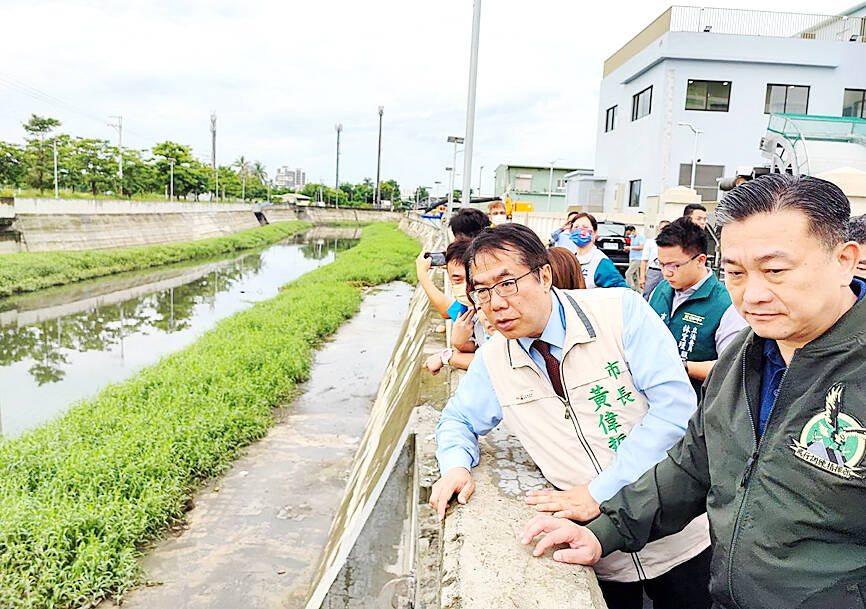Typhoon Doksuri might cause Tainan’s dengue fever outbreak to worsen in the coming days, Tainan Mayor Huang Wei-che (黃偉哲) said on Wednesday, as the total number of confirmed cases rose to 587.
Rainfall from the typhoon would complicate the municipality’s efforts to stop the spread of dengue fever by flooding the basements of old housing projects, unoccupied structures, vacant lots and construction zones, he told a meeting at the city’s epidemic command center.
“The city’s challenges will begin only after the storm,” the Tainan Public Health Bureau quoted the mayor as saying in a statement.

Photo: Wu Chun-feng, Taipei Times
The typhoon would likely drive mosquitoes into residential buildings, thereby heightening infection risks throughout the city, Huang said, urging health officials to be vigilant.
Huang instructed municipal personnel to be thorough in the post-storm cleanup, citing data indicating that mosquito activity is likely to surge in the week following heavy rain.
Extreme climate events this year have significantly increased dengue fever risks, while changes in urban demographics have encouraged the disease’s range of propagation, said Chan Chang-chuan (詹長權), a professor at National Taiwan University’s College of Public Health.
Countering this effect would require the city to adapt its disease control strategy on a district-by-district basis, he said.
Tainan on Wednesday reported 30 new domestic dengue fever cases, including 15 in Yongkang District (永康), five in East District (東區), four in Rende District (仁德) and two in South District (南區).
They also included one reported case each in North District (北區), Annan District (安南), Gueiren District (歸仁) and Guanmiao District (關廟), the bureau said, adding that cases have been reported in 12 of the city’s 37 districts.
The infected ranged from age four to 81, with 25 cases being reported by hospitals or clinics and five more discovered after officials conducted contact tracing, the bureau said.
The bureau on Tuesday inspected 248 households and discovered six vessels containing mosquitoes in three of the homes, it said.

Trips for more than 100,000 international and domestic air travelers could be disrupted as China launches a military exercise around Taiwan today, Taiwan’s Civil Aviation Administration (CAA) said yesterday. The exercise could affect nearly 900 flights scheduled to enter the Taipei Flight Information Region (FIR) during the exercise window, it added. A notice issued by the Chinese Civil Aviation Administration showed there would be seven temporary zones around the Taiwan Strait which would be used for live-fire exercises, lasting from 8am to 6pm today. All aircraft are prohibited from entering during exercise, it says. Taipei FIR has 14 international air routes and

Taiwan lacks effective and cost-efficient armaments to intercept rockets, making the planned “T-Dome” interception system necessary, two experts said on Tuesday. The concerns were raised after China’s military fired two waves of rockets during live-fire drills around Taiwan on Tuesday, part of two-day exercises code-named “Justice Mission 2025.” The first wave involved 17 rockets launched at 9am from Pingtan in China’s Fujian Province, according to Lieutenant General Hsieh Jih-sheng (謝日升) of the Office of the Deputy Chief of the General Staff for Intelligence at the Ministry of National Defense. Those rockets landed 70 nautical miles (129.6km) northeast of Keelung without flying over Taiwan,

City buses in Taipei and New Taipei City, as well as the Taipei MRT, would on Saturday begin accepting QR code payments from five electronic payment providers, the Taipei Department of Transportation said yesterday. The new option would allow passengers to use the “transportation QR code” feature from EasyWallet, iPass Money, iCash Pay, Jkopay or PXPay Plus. Passengers should open their preferred electronic payment app, select the “transportation code” — not the regular payment code — unlock it, and scan the code at ticket readers or gates, General Planning Division Director-General Liu Kuo-chu (劉國著) said. People should move through the

The Ministry of National Defense (MND) today released images of the military tracking China’s People's Liberation Army (PLA) movements during the latest round of Chinese drills around Taiwan. The PLA began "Justice Mission 2025" drills today, carrying out live-fire drills, simulated strikes on land and maritime targets, and exercises to blockade the nation's main ports. The exercises are to continue tomorrow, with the PLA announcing sea and air space restrictions for five zones around Taiwan for 10 hours starting from 8:30am. The ministry today released images showing a Chinese J-16 fighter jet tracked by a F-16V Block 20 jet and the